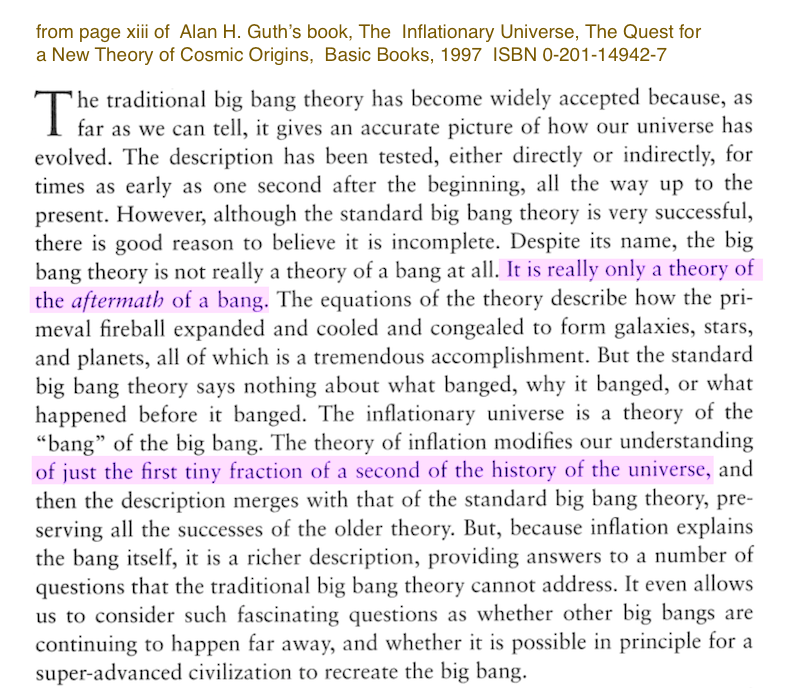This note is a result of a posting about the so-called Inflationary Epoch.
In 1978 and 1979 Alan Guth of MIT wrote groundbreaking works whereby
his concept of The Inflationary Universe became part of the core anatomy
of the big bang theory.
This note was sent to Prof Dr. Guth via email and it was titled, Inflationary processes:
July 6, 2016
TO: Prof. Dr. Alan Guth, Victor F. Weisskopf Professor of Physics, MIT
Dear Prof. Dr. Alan:
I was born in July 1947, so you are my senior; and, I write
with admiration and respect for what you have accomplished.
There is a special confidence that one gets from affirmations
especially from being published. It seems so very eternal.
My question comes out of work done in a high school geometry
class when we ducked inside a tetrahedron, found half-sized
tetrahedrons in the four corners and an octahedron in the middle.
We then went inside that octahedron, divided each edge by 2, and found
half-sized octas in each of the six corners and the tetras in each
of the eight faces. A perfect tessellation, it was easy to continue.
In about 40 jumps within, we were down among the protons.
In another 67 we were in a singularity with the Planck base units.
Feeling a little uncomfortably tight, we quickly multiplied
those base units by 2 and in 201 notations we were lost,
but looking at ourselves from out in-and-around
the Age of the Universe and the Observable Universe.
Now, this is all happening just up river from New Orleans
Zoo, downriver from the NOLA international airport. We’re
just high school folks and the kids.
That was 2011. We rushed right by Kees Boeke, my old MIT
friend, Phil Morrison’s charge. When we included all
five Planck base units, it got very challenging.
1. Nobody talks about those 67 notations from the
fermion-proton range down to the first Planck base
units’ doublings.
“Much too small to be meaningful!”
say the kings and queens of physics.
Why? “Off with your head!” (in the spirit of Alice
in Wonderland’s Queen of Hearts).
2. Really now, if Max Planck found a path to such
small numbers (length, time, mass) and to the not
so small charge, and to an absolutely gargantuan temperature,
shouldn’t there be a way to get to them through with
a bit of simple logic and simple math?
Why not?
We’ve mapped it out in a large horizontal chart:
https://bbludata.wordpress.com/1-204/
It’s rich with information, but it could be all wet.
Any advice for us literal abstractionists?
Thanks.
Most sincerely,
-Bruce
*****************
Bruce Camber\
http://bblu.org
PS. Long ago, in 1976, I was the guest of Victor Weisskopf
at the MIT faculty club where I had arranged for a WSJ writer
to interview him for an ““A-Hed” article. It was to be about
how the chairman of the MIT physics department was involved
with the Pontifical Academy of Sciences in Rome. Though
the article was never published, Weisskopf invited me to
his home to review great artwork, some quite religious,
that challenged our understanding of space and time.
About six months later, on a trip to visit with folks in
Geneva at both CERN and the World Council of Churches,
Weisskopf arranged my first meeting with John Bell to
talk about the EPR paradox and his inequalities.
Then, in 1979, I had a display project under the dome
at 77 Massachusetts Avenue called, “What is life?”
after Schrodinger’s book of the same title. It was
an attempt to examine the first principles and answers
to the question by 77 leading, living scholars from around the world.
Jerome Wiesner buttonholed me at that time, “What’s this?”
thinking it was a right-to-life group! Such memories.
So, I am still wrestling with the same old questions!
These paragraphs from the preface of your book,
The Inflationary Universe, I enjoy:

Thanks. -BEC